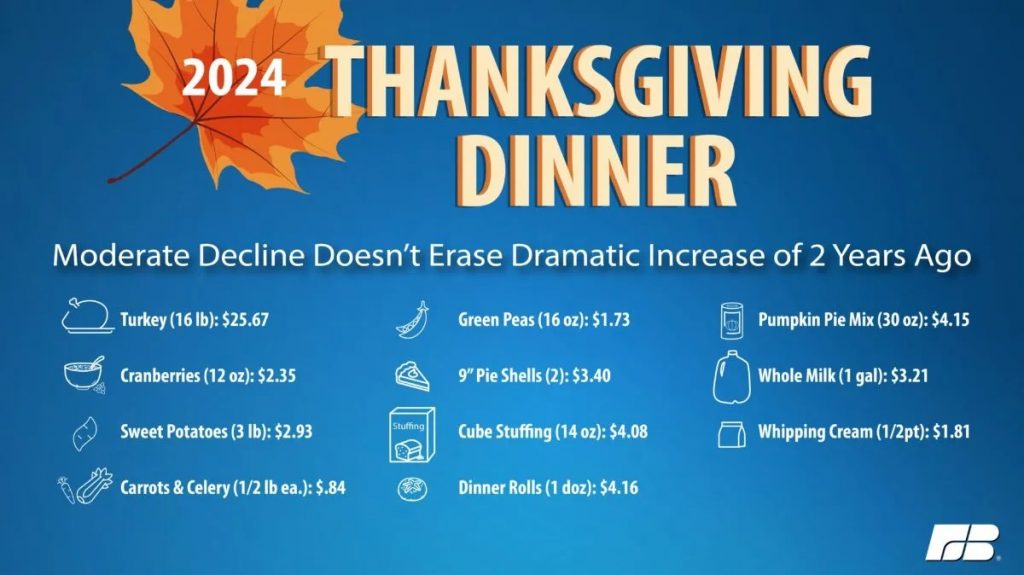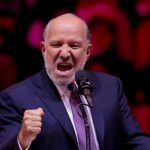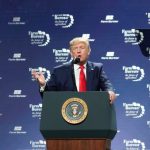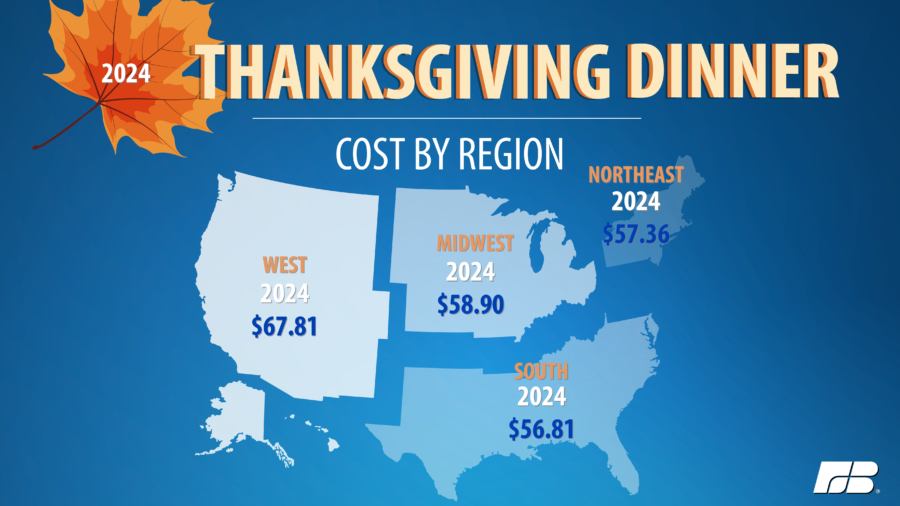
Americans stocking up for this year’s Thanksgiving dinner will see a dip in their grocery bills for the second year in a row. The 39th annual American Farm Bureau Federation (AFBF) Thanksgiving dinner survey finds that the classic feast for 10 will run you $58.08, down 5% from last year. However, this is still 19% higher than five years ago. While consumers are getting some much-needed relief after years of elevated retail prices, these grocery bills also reflect some hard conversations around the dinner table for farm and ranch families.
The Thanksgiving Dinner Survey
For one week each year, volunteer shoppers from all 50 states and Puerto Rico visit their local grocery store (or local store’s website) to survey the prices of items used in a classic Thanksgiving feast. Since 1986, these volunteers have collected price data on turkey, cubed stuffing, sweet potatoes, dinner rolls, frozen peas, fresh cranberries, celery, carrots, pumpkin pie mix and crusts, whipping cream and whole milk.
The classic dinner’s grocery bill is a mixed bag of savings and squeezes. Seven items dropped in price this year, including turkey, sweet potatoes, frozen peas, a vegetable tray of carrots and celery, pumpkin pie mix, pie crusts and whole milk. However, the remaining four items –dinner rolls, fresh cranberries, whipping cream and cubed stuffing – rose in price.
Prices for ham, Russet potatoes and frozen green beans were added to the survey in 2018 to reflect more Thanksgiving favorites, with all of them showing a year-over-year reduction in price. When including the additional items, the meal cost rose to $77.34, or $7.73 per person, with more leftovers, of course. The updated Thanksgiving dinner nearly doubled the cost savings of the classic basket – an 8.7% decrease in price from 2023.
Turkey – Carving the Grocery Bill
Over the span of the AFBF Thanksgiving survey, turkey has accounted for an average of 43% of the total dinner cost. This year is right on the mark – a 16-pound turkey accounts for 44.2% of the classic 10-person feast. Given its large share of the total dinner bill, differences in the grocery bill year-over-year closely follow the change in turkey prices. This year’s 6% decrease in turkey prices is a bit of an anomaly. According to USDA’s Turkeys Raised report, farmers raised 205 million turkeys in 2024, down 6% from last year and the lowest since 1985. Highly Pathogenic Avian Influenza is responsible for the decline in turkeys raised. Typically, fewer turkeys would mean an increase in price, but demand for turkey fell in 2024. USDA estimates per capita demand for turkey is 13.9 pounds per person, down a pound from 2023. This drop in demand has caused prices to fall.
The Rest of the Thanksgiving Dinner Table
Most ingredients in our survey decreased in price including fresh vegetables and the centerpiece of our Thanksgiving table, the turkey. Overall price volatility in vegetables pulled fresh vegetable prices down, including those on the celery and carrot relish tray. Favorable weather conditions for dairy cows and feedstuffs led to a 14% decrease in the price for a gallon of whole milk. It’s important to note that milk prices varied significantly between regions across the country.
The largest increases in your Thanksgiving dinner bill this year come from processed products. Dinner rolls and cubed stuffing both increased over 8% from 2023. Nonfood inflation and labor shortages have driven up costs for partners across the food supply chain.
Fresh cranberries had the next-largest price increase at 12%. This is a stabilization of prices after a significant 18% drop in prices from 2022 to 2023. Despite the year-over-year price increase, cranberries are still more affordable than historical averages. In fact, when adjusted for inflation, this is the lowest price for cranberriessince 1987.
Regional Differences – More than Dressing vs. Stuffing
Thanksgiving staples, and what you call them, are not the only things that vary as you move across the United States. For those celebrating in the West, your grocery bill will be at least 15% steeper than the rest of the country: $67.81 for a party of 10. The other regions of the U.S. are lower by 9 dollars or more. Southern dinners will cost the least at $56.81, followed closely by the Northeast at $57.36 and $58.90 in the Midwest.
When looking at the expanded Thanksgiving basket, the West also has a divide from the rest of the country. The South, Northeast and Midwest can add ham, Russet potatoes and green beans for a basket total of $81.07, $81.37 and $83.03, respectively. However, the expanded Thanksgiving basket in the West costs $94.09, over a dollar more per person.
The Cost of Food
Even though the price tag for this year’s Thanksgiving meal is down 5%, it’s still up nearly 20% from just five years ago. Consumers are exhausted from years of inflation, and it will take more than the past two years’ improvements to ease the pain. However, these declines are reflective of the greater affordability of food in the United States. Rising grocery bills might be a bit of a shock, but food inflation is a fraction of the hikes hitting other expenses. From October 2023 to 2024, food at home prices generally rose only 1.1%, half of the total economy’s 2.6% increase in prices. Other bills that may have even larger spikes include transportation (up 8.2%), housing (up 4.9%) and electricity (up 4.5%). When adjusted for inflation – or if your dollar had the same overall purchasing power as a consumer in 1984, right before the beginning of this survey – this would be the least expensive Thanksgiving meal in the 39-year history of the AFBF Thanksgiving survey, other than the outlier of 2020. Even with the decreasing purchasing power of the dollar, some of the goods in our basket are at their long-term lowest prices, even in terms of the “current dollar” price. Cranberries are the second-lowest, following only last year’s large drop in price, since 2015.
We can also look at food affordability in terms of wages. American consumers spent 6.7% of their expenditures on food in 2022, including food eaten away from home or takeout, the lowest percentage in the world. For comparison, the food share of expenditures is 8.5% in the United Kingdom, 16.2% in Brazil and up to 59% in developing countries like Nigeria.
The average American also has to work fewer hours to buy the same meal than in previous years. Wages continued to grow faster following the COVID-19 pandemic, even as inflation cooled. Because average wages rose 4% from 2023 to 2024, it took 9% less work time for us to pay for this year’s Thanksgiving dinner.
Back on the Farm
While consumers are seeing some signs of retail food price stability, farmers are experiencing lower and more volatile prices at the farm gate. And just like consumers, they are also victims of inflation, as their production costs rose steeply over the last few years. USDA projects national net farm income will fall by $6.5 billion in 2024.
Put simply, farmers are price takers, taking on the greater price volatility that gives the food supply price stability. On average, 9.3 cents of every dollar spent on food goes back to the farmer producing it; but this share varies from product to product. When products are less processed, a greater share of every dollar goes back to the farmer, and consumers also experience more of the price variability that the farmer faces. Examples include products such as meat, milk and vegetables, which tend to have more price variability at the grocery store, giving consumers a taste of the price volatility that farmers experience.
Give Thanks for Supporting Farms
The farmers and ranchers who grow the food on your table this Thanksgiving face many challenges. Low crop prices, poor growing weather, disasters like the recenthurricanes and shifting international markets all threaten farmers’ livelihoods. Congress has historically provided help in the form of the farm bill and in exceptional situations, disaster relief. The most recent farm bill expired this fall, already six years old and out of date; and disaster relief in recent years has been short and severely delayed, hampering recovery for farmers and rural communities. This support, when timely and effective, is one of the most important tools to keeping America’s food supply safe, affordable and secure.
Conclusion
According to AFBF’s national Thanksgiving survey, this year’s Thanksgiving meal will cost consumers about 5% less this year, though it is still up almost 20% from just five years ago. The long road to reduced inflation has exhausted many Americans, including farm families, who have been squeezed between falling prices for their output and higher prices for their inputs. Farmers take on much of the food system’s risk to help keep food plentiful and affordable. When times get tough, they have relied on a strong farm bill (and effective assistance, when disaster strikes) to provide the help to stay in business.
You can now read the most important #news on #eDairyNews #Whatsapp channels!!!
🇺🇸 eDairy News INGLÊS: https://whatsapp.com/channel/0029VaKsjzGDTkJyIN6hcP1K






















